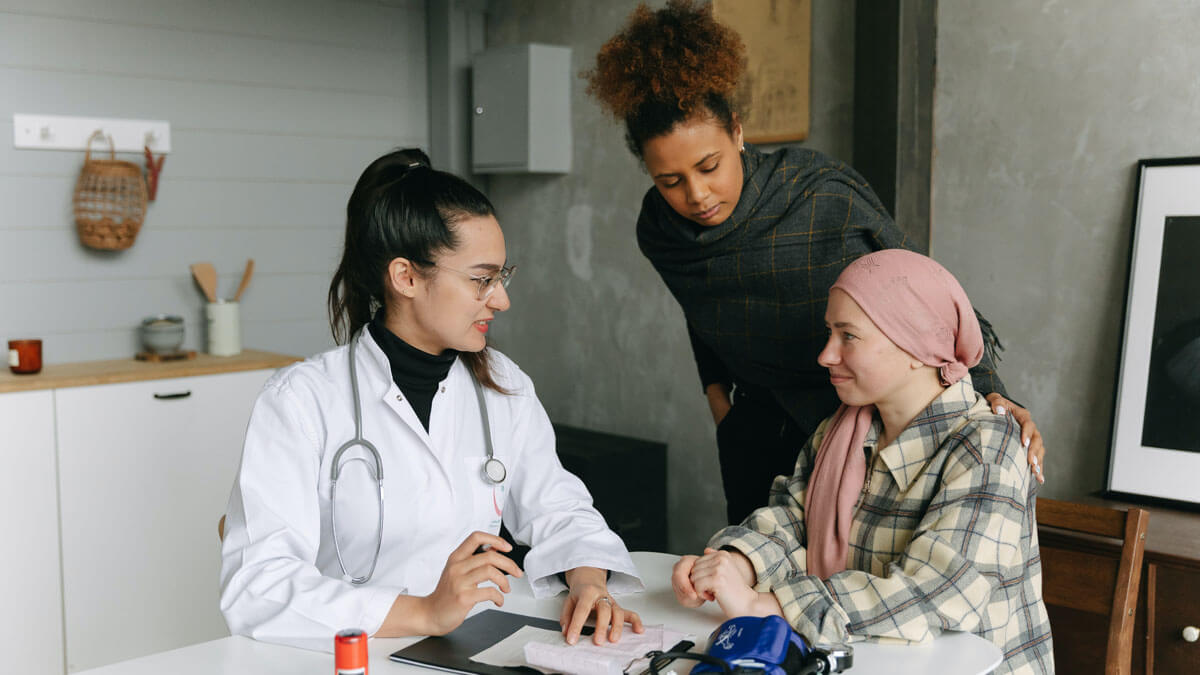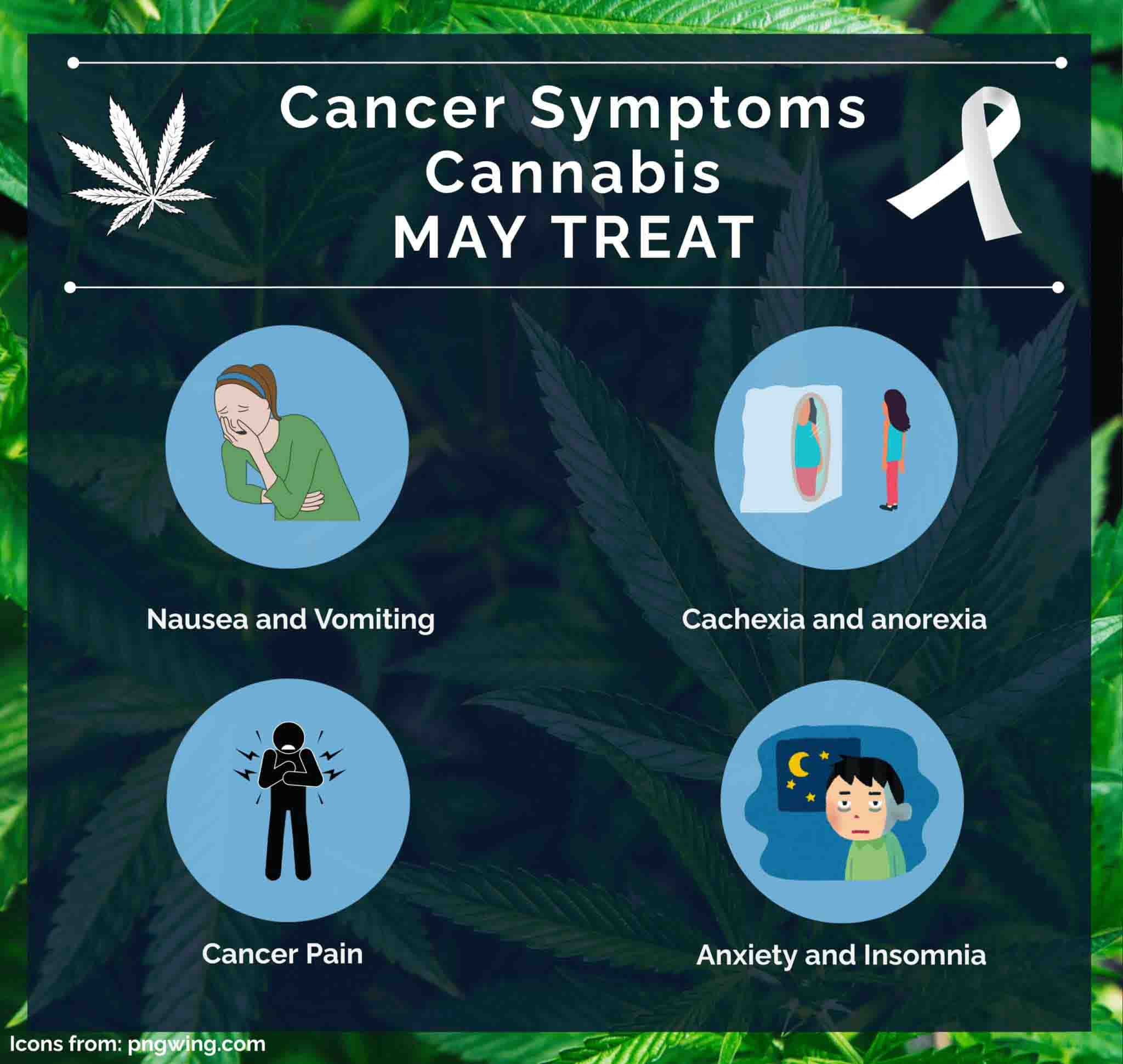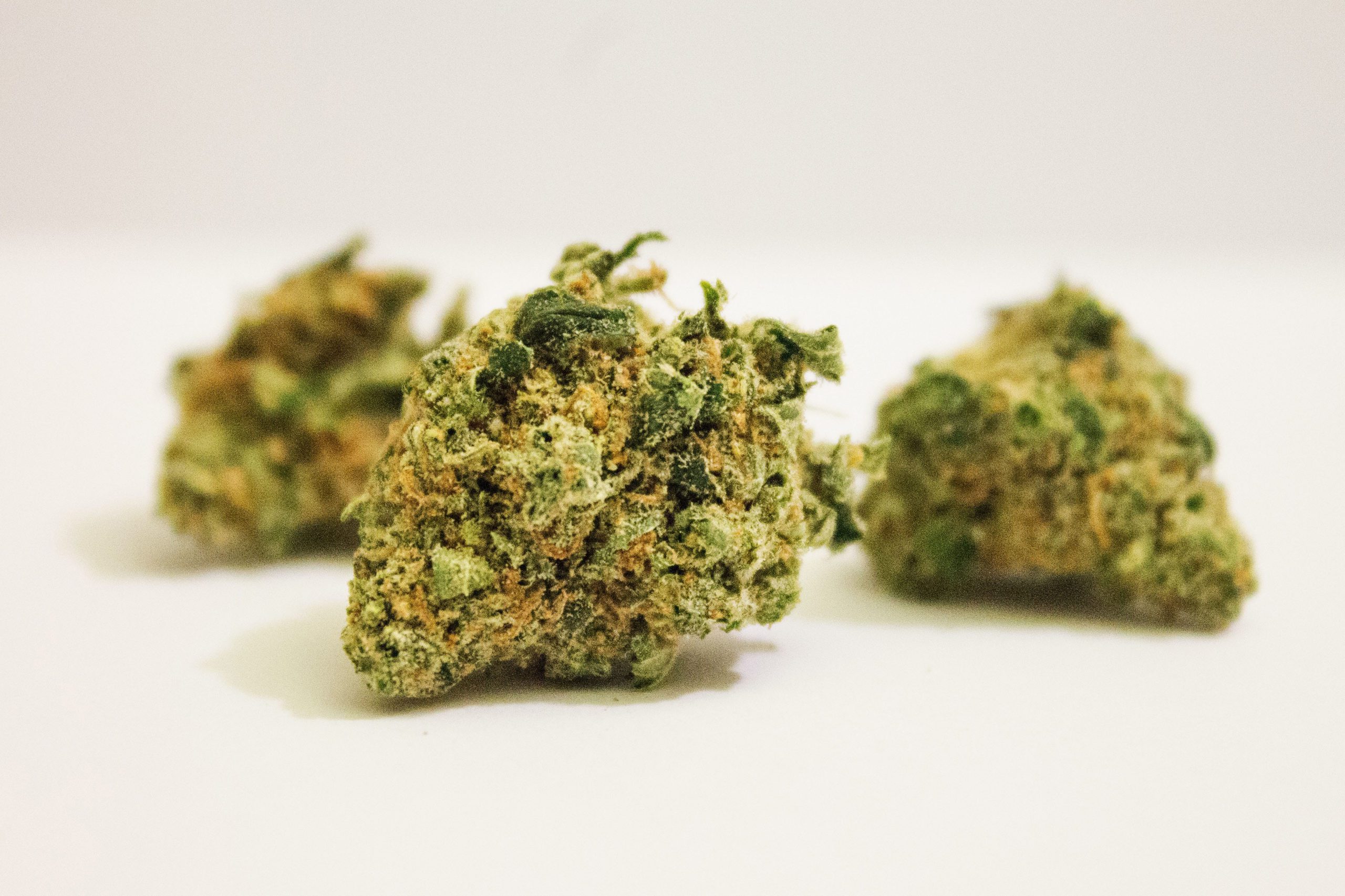Marijuana for Cancer: Highly Effective or Glass Hammer?
Written By QuickMedCards. Reviewed by Dr. Shatha Atiya, PsyD. Updated June 13, 2025
Hardly ever is medical marijuana mentioned without thinking of the duo—marijuana and cancer.
When it comes to the treatment of cancer with marijuana, there are two possible roles for the herb.
First and most controversially, as a primary treatment for cancer. This would mean that marijuana would be at the forefront when treating cancer and be accepted, plus regarded as the best treatment option among all others.
Second, is marijuana’s ability to ease cancer-related symptoms and the side effects of cancer treatment.

Looking for a Medical Marijuana Doctor?
Unfortunately, the classification of marijuana as a Schedule I controlled substance has limited scientific research into its potential benefits and side effects on cancer. Especially for the former argument; as a primary treatment for the malady.
Recent studies have revealed that cannabis may play a role in slowing the growth or stimulating the dying process of certain cancer cells. But, these conclusions come from in vitro tests and animal models.
An in vitro test refers to a test done in a lab dish or test tube. So, chances of the same happening in the human body can only be determined through human trials.
Nevertheless, the effectiveness of cannabis against countering the crude side effects of chemotherapy is not under much debate like its ‘cancer curing’ properties.
Often, cancer patients undergoing chemotherapy along with marijuana treatment experience reduced nausea and vomiting, appetite stimulation, decreased cachexia (severe wasting), and pain inhibition.
Moreover, positive psychological effects such as reduced anxiety and improved quality of sleep among cancer patients favor marijuana as an effective all-around drug.
Going forward, we aim to demystify the role of cannabis in cancer treatment. To shed more light on this contentious topic, preclinical studies and patient testimonies will play an important role throughout.
Contents
- How marijuana helps with cancer
- Cannabis for nausea and vomiting
- Best strains for nausea
- Appetite stimulation
- Pain-relieving effects of marijuana
- Reduce anxiety and improve sleep
- Antitumor effects
- What is marijuana?
- What is cannabis (CBD) oil?
- RSO oil and cancer
- Best edibles for cancer
- The FDA’s stance on cannabis and cancer treatment
- The American Cancer Society’s stance on marijuana for cancer
- Olivia Newton-John’s Struggle with Breast Cancer
- Disadvantages of Marijuana for Cancer Treatment
- Speak to an MMJ doctor
- Key takeaways
Marijuana for Cancer
So what makes marijuana and cancer a suitable pairing?
It comes down to the medicinal value marijuana has for cancer and its symptoms as mentioned earlier.
How Marijuana Helps with Cancer
To begin, let’s take a look at the various symptoms affecting cancer patients that marijuana may subdue. They include:
- Nausea and vomiting
- Cachexia or severe wasting
- Chronic pain (especially neuropathic pain)
- Anxiety and insomnia

Cannabis for Nausea and Vomiting
Cancer treatments such as radiation and chemotherapy often cause nausea and vomiting. Additionally, drugs such as targeted therapy and immunotherapy often lead to the same outcome.
Chemotherapy has such a propensity to cause nausea and vomiting that this side effect has a name of its own; chemotherapy-induced nausea and vomiting (CINV).
Depending on when it happens, CINV comes in many forms. For example:
- Acute nausea and vomiting: This occurs in minutes or hours after treatment. Particularly if the treatment was administered through IV infusion or taken orally.
- Delayed nausea and vomiting: Usually starts more than 24 hours after treatment and persists for a few days even after the treatment ends.
- Anticipatory nausea and vomiting: A conditioned response since the body has become ‘used to’ nausea and vomiting during chemo. And, it can happen either before or after treatment.
- Breakthrough nausea and vomiting: This occurs within 5 days despite the administration of medicine to mitigate nausea and vomiting. Normally, the patient receives different drugs or a higher dose to deal with it.
- Refractory vomiting: Like Breakthrough CINV, refractory vomiting persists even after taking more doses of different types of antiemetic (antinausea) drugs. Often happens after Breakthrough CINV.
Nausea is believed to take place when there is stimulation in one of the sensory centers in the brain or digestive tract.
Researchers to date don’t seem to fully understand why chemotherapy causes nausea and vomiting. But, the assumption is that the drugs or their respective digestive byproducts may play a significant role.
How does cannabis or CBD oil work to prevent nausea and vomiting?
The scientific lingo involved in explaining how the components of cannabis, mainly THC (tetrahydrocannabinol) and CBD (cannabidiol), react with the endocannabinoid system to prevent cancer-induced nausea and vomiting may be a bit overwhelming.
However, one study by Linda A. Parker et al., concludes that the primary non-psychoactive compound in cannabis, CBD, suppresses nausea and vomiting within a limited range of dosage.
Best Strains for Nausea

The following strains are effective for mitigating the instances of nausea and vomiting among cancer patients:
1. Chemo strain
Sativa, Indica, or hybrid? The Chemo strain is a heavy Indica strain.
Effects: This potent Indica strain manifests itself as a heavy feeling behind the eyes and at the back of the neck. The Chemo strain then fades into a pleasant relaxing feeling which washes away all the pain and leaves the user feeling ravenous and sleepy.
Medical value: Because of its heavy sedative effects, patients seeking a break from chronic pain, insomnia, appetite loss, and nausea will appreciate the Chemo strain.
Time to use: Because of its ability to leave the user couch-locked and sleepy, the Chemo is best for evening use to enjoy dinner and a good night’s rest.
Bonus information: Rumor has it that the Chemo strain was developed to improve the side effects of chemotherapy.
2. D Cure Strain
Sativa, Indica, or hybrid? The D Cure strain is an Indica dominant hybrid with genetics from the Chemdawg D and Grape Stomper BX2 strains.
Effects: The D Cure strain expresses itself as a creeping feeling beginning at the back of the mind which suddenly takes hold and throws the user into a cerebral state of unfocused calm and ease.
As the mind settles, the body follows suit and succumbs to a heavy tingle leaving users couch-locked before realizing it.
Medical value: Conditions such as chronic pain, chronic stress, depression, nausea, and appetite loss are no match for the D Cure strain.
Time to use: The intensity of the D Cure strain makes it a great evening strain.
Bonus information: The D Cure strain packs a heavy high that hits both mind and body with almost unrivaled potency.
3. Brain Freeze Strain
Sativa, Indica, or hybrid? The Brain Freeze strain is a hybrid strain.
Effects: The hybrid nature of the Brain Freeze strain enable it to deliver well-balanced and strong effects.
Its effects are almost instant where the Sativa effects start as a very cerebral and focused high. Afterward, the effects begin to be felt across the body and that’s when the Indica part of the strain takes over.
This strain leaves users high for a minute or so before feelings of sleepiness take control.
Medical value: The Brain Freeze strain wipes out all feelings of nausea, chronic pain, joint pain, and stress.
Time to use: The Brain Freeze strain suits the nighttime where the user can peacefully drift off to sleep.
Bonus information: Cigar enthusiasts will find the cigar-like aroma of the Brain Freeze strain appealing
4. Remedy Strain
Sativa, Indica, or hybrid? The Remedy strain is an Indica leaning hybrid with genetics from the Cannatonic and Afghan Skunk strains.
Effects: The Remedy strain lifts users to a state of mellow relaxation and little to no mind-altering effects take place.
Medical value: The Remedy strain excels in treating seizures, pain, autism, anxiety disorders, nausea, and inflammation.
Time to use: The Remedy strain is a perfect daytime strain.
Bonus information: The unique composition of the Remedy strain makes it a medical strain. Unlike the other strains, it contains a high CBD content and a low THC content; completely different from the other strains which have high THC and low CBD.
5. Blue Dream Strain
Sativa, Indica, or hybrid? The Blue Dream strain is a popular Sativa dominant strain that comes from crossing the Blueberry strain with the Haze strain.
Effects: The Blue Dream strain has an almost immediate onset where users feel an uplifting cerebral high leaving them motivated and focused with surges in creativity.
Later on, a relaxing body high takes over leaving users feeling warm, numb, and completely pain-free.
Medical value: The Blue Dream strain shines when treating chronic pain, nausea, depression, stress, and sleep disorders. Its qualities may make it the best strain for nausea.
Time to use: This strain may work as a daytime or evening strain depending on the dosage. In lower doses, users can enjoy a boost in mood and creativity during the day. And in higher doses, users can unwind and enjoy a peaceful evening.
Bonus information: The Blue Dream strain has a delicious aroma of sweet blueberry pie and the taste of sugary sweet blueberries sticks on the tongue long after smoking.
Appetite stimulation
Next on the list of vexing symptoms caused by cancer is cachexia also known as anorexia or wasting syndrome.
Patients drastically lose their lean body mass plus their appetite. In dire situations, cachexia may hasten death if not attended to.
Depending on the type of cancer, 50-80% of patients develop cachexia, especially those going through the final stages of pancreatic, lung, or prostate cancers.
It is thought that cytokines, proteins produced by the immune system in response to the tumor stimulate the wasting process.
Marijuana, renowned for its ability to stimulate appetite through “the munchies” is perfect to get patients eating once more. However, despite the possible weight gain, patients seldom recover their lean body mass and gain fat instead.
This property of marijuana has also been used to help AIDS patients reverse the course of cachexia.
Pain-relieving effects of marijuana
Pain is typical of cancer throughout all of its stages. And its elimination or decline is key to improving the quality of life in cancer patients.
Cancer pain frequently comes from inflammation, invasion of bone or other pain-sensitive structures, or nerve injury. Often, neuropathic pain is the most common type of chronic pain experienced. And this type of pain is resistant to treatment with opioids.
In one study, researchers examined the effects of a cannabis extract with controlled cannabinoid content in an oral spray. It involved patients with advanced cancer who experienced moderate to severe cancer-related pain.
Ultimately, the researchers concluded that a THC: CBD extract proved effective in advanced cancer patients whose pain wasn’t relieved by strong opioids.
Reduce anxiety and improve sleep
Too often are cancer patients swamped in negative thoughts. Indeed, the burden of a cancer diagnosis is a lot to bear. And since you are already battling a disease, being at war with yourself is the last thing you need.
Cannabis improves your mood, sense of well-being, and reduces anxiety. This may come from the euphoric effects of THC or the calming effects of CBD.
With diminished pain and reduced anxiety, patients can relax and have well-deserved rest and recovery.
As in the case of PTSD, THC works to reduce REM sleep; a stage in the sleep cycle when we experience vivid dreams. Thus, by having a reduced period of dreaming, cancer warriors can fall into a deep and restorative slumber.
Antitumor effects
On the surface, marijuana doesn’t seem nearly as aggressive or as potent as the alternatives for cancer treatment such as chemotherapy, radiation, or surgery.
However, scientific inquiries have reported that cannabinoids may cause antitumor effects through various mechanisms. For instance:
- Cause cell death or shrink tumors
- Block or slow cancer growth
- Stop the development of new blood vessels needed for tumors to grow (angiogenesis)
- Preventing the spread of cancer from the source to other parts of the body (metastasis )
Moreover, cannabinoids such as THC appear to kill cancer cells with no effect on normal cells and protect them from cell death.
An animal model supported this argument when cannabinoids induced apoptosis (death of cells) in glioma cells leading to regression of glioma tumors in rats and mice while protecting normal glial cells from apoptosis mediated by the CB1 receptor.
Further studies have confirmed that both CB1 and CB2 receptors may be potential targets in non-small cell lung carcinoma and breast cancer. Also, inquiries have demonstrated the antitumor effects of cannabinoids on preclinical models of breast cancer.
To conclude, CBD may enhance the uptake of cytotoxic drugs (substances that kill cells) into malignant cells. Similarly, both THC and CBD may enhance the antitumor activity of chemotherapeutic drugs as seen in mouse models.
Potential ways cannabis prevents cancer
Another study involving mice implied that cannabinoids may have a preventive effect against the development of certain tumors. During the 2-year study, THC was administered to the mice. And at the end of the study, the scientists noted a dose-related decline in the prevalence of:
- Hepatic adenoma tumors: a rare benign tumor that occurs in the liver.
- Hepatocellular carcinoma: the most prevalent form of primary liver cancer.
Additionally, there were fewer cases of benign tumors in other organs of the mice.
What is Marijuana?
Marijuana is the name given to the dried leaves, flowers, stems, and seeds from the two main species of the cannabis plant— Cannabis Sativa and Cannabis Indica.
It is also known in a variety of slang terms. For example, pot, weed, dope, ganja, hashish, grass, bud, Mary Jane, etc.
Marijuana has long been the most commonly used illegal drug in the United States. However, in recent years, there has been a shift in opinions towards its use. It seems that marijuana is no longer just a dangerous drug, with many states legalizing cannabis for medicinal purposes and some even for recreational use. In fact, many nations are beginning to recognize the potential therapeutic benefits of cannabis, following in the footsteps of traditional healers who have used it for centuries to treat a wide range of illnesses. It’s a fascinating change that could have a monumental impact on the future of medicine.
What is Cannabis (CBD) Oil?
Cannabis oil or CBD oil is cannabidiol (CBD) derived from the hemp plant. Its defining trait is its high CBD content and contrastingly low THC content which is usually less than 0.3%.
Unlike THC, CBD is the non-psychoactive compound in marijuana. Despite lacking a punch in the ‘high’ department, its anti-inflammatory properties make it useful in pain relief and improvement of mood.
Companies like InstacraftCBD have made a name for themselves by producing high-quality pure CBD oil. And since CBD oil is legal for purchase without joining a state’s marijuana program, it is more accessible.
Effects of cannabis (CBD) oil on cancer
As mentioned earlier, CBD helps stimulate apoptosis; the body’s natural mechanism of destroying cells which is absent during cancer development.
So, CBD latches onto the CB2 receptors of the endocannabinoid system and ‘alerts’ them that there might be invaders detrimental to the body’s health.
Following this binding, the endocannabinoid system signals an antitumorigenic warning. And this warning impairs cancer development by inhibiting reproduction, metastasis, and tumor angiogenesis.
RSO Oil and Cancer
Rick Simpsons’ Oil (RSO) is a full extract of cannabis oil derived from marijuana meant to be taken orally or applied topically (like a cream or lotion).
The main difference between RSO and CBD oil comes in their THC content. As previously mentioned, CBD oil contains less than 0.3% of THC. Conversely, RSO has a lot more THC, usually above 20%. Additionally, RSO contains other cannabinoids present in marijuana.
Benefits of RSO oil for cancer
Since RSO is marijuana in concentrated form, it has the same effects that cannabis has on cancer.
For instance, the high THC content in the product aids in quelling nausea and vomiting in cancer patients while CBD contributes to the antitumor properties.
Is there a risk of an RSO overdose?
Because Rick Simpson’s Oil is packed with THC, the chances of experiencing an RSO overdose are very high. To clarify, a marijuana overdose is not fatal but the experience is very unpleasant.
Possible signs of an RSO overdose may include:
- Extreme anxiety
- Panic attacks
- Rapid heart rate
- Extreme confusion and memory problems
To mitigate the symptoms of an RSO overdose one should consume CBD oil (CBD counters the effects of THC), drink a lot of water, have something to eat, get some sleep, or chew peppercorns.
Best Edibles for Cancer

Many times cancer patients prefer cannabis edibles to other forms of medical marijuana.
This is mainly because of the seemingly more potent and longer-lasting effects of cannabis edibles compared to other forms of medical marijuana available.
However, by picking edibles over other options such as smoking or vaping, patients trade-off immediate relief for the delayed-release and long curve effects.
Another reason cancer patients prefer edibles is because methods such as smoking and vaping may do more harm than good for patients battling cancers such as lung cancer.
With this preference for edibles, cancer patients are curious about knowing the best edibles for cancer.
Edibles are probably the most diverse group of medical marijuana available. They come in very many fun shapes, sizes, and forms. For example:
- Weed gummies
- CBD gummies
- Weed brownies
- Cannabis cookies
- Chocolate weed
- Popcorn weed
- Cannabis tea
Which are the best edibles for cancer and why?
Weed gummies: The most popular choice of edibles because of their wide range of colors and sweet taste. The combination of the sugary content of the gummies and marijuana makes them more potent compared to other edibles.
Cannabis cookies: These edibles are appealing to cancer patients because of the sheer variety of cannabis cookies available. This is because every marijuana dispensary can forge its creations.
Chocolate weed: Another tasty option for patients who prefer to microdose (taking their medical marijuana in small doses).
Dissolvable cannabinoid powders (THC powder): A new entrant into the edible cannabis scene. Users who find the taste and smell of cannabis repulsive will favor THC powders since they are tasteless and odorless. Another advantage is that these powders can be added to just about anything. For instance juices, sodas, smoothies, and even protein shakes.
Tinctures: Are usually placed under the tongue to be absorbed by either the mouth or tongue. They are normally fast-acting but patients can add them to food or drinks for more delayed and stronger effects. Their dual purpose and the ability to dose accurately make them one of the best edibles for cancer.
Disadvantages of edibles for cancer
The first disadvantage of edibles is the time it takes for the effects to be felt (it may take 30 minutes to 2 hours for the effects to kick in). For this reason, those seeking immediate relief are at a disadvantage.
Secondly, because of the delayed effects of edibles, patients may be tempted to overconsume.
As a result, patients may be overwhelmed once the effects begin to manifest and this would lead to unfavorable effects.
In the event of a marijuana overdose with edibles, patients should follow the same procedure as highlighted in the event of an RSO overdose.
Edibles dosing
As mentioned earlier, many patients often get caught off-guard by the stronger potency and longer-lasting effects of edibles.
So how can patients avoid this?
When it comes to edibles dosing several factors come into play. For example:
- The amount of THC in the edibles
- Bodyweight of the patient
- The patient’s last meal
- A patient’s tolerance level
- Other medications the patient may be taking
Because of all these factors, it’s advisable that a patient starts slow and then proceeds slowly with the edibles they consume. For better dosing, use our edible dosage calculator to find the best potency to start with.
Typically, 10mg of THC is considered a single dose of an edible, but some products may come with several doses in one package.
Therefore, reading the label is crucial when determining how much marijuana you plan to have.
It’s an unwritten rule that beginners should take at most 5mg of THC, to begin with.
2.5mg is enough to bring about relief from mild symptoms and a feeling of relaxation minus the mind-altering effects synonymous with marijuana.
Upping the dosage to 3mg-15mg is sufficient to mitigate the more aggressive symptoms of cancer.
Going beyond 16mg would lead to more intense effects and is best reserved for experts.
The FDA’s Stance on Cannabis and Cancer Treatment
The U.S. Food and Drug Administration hasn’t approved the use of cannabis or cannabinoids for cancer treatment.
Yet, it has approved two cannabinoids for the treatment of nausea and vomiting in cancer patients undergoing chemotherapy who are unresponsive to other antiemetic treatments. They include:
- Marinol and Syndros (Dronabinol)
- Cesamet (Nabilone)
In addition to these, the only other FDA-approved cannabis-derived product is Epidiolex; which contains a purified form of CBD to treat seizures associated with Lennox-Gastaut or Dravet syndrome.
Marinol
The FDA approved Marinol in 1985 as a remedy for nausea and vomiting associated with cancer chemotherapy. Dronabinol is the active synthetic THC cannabinoid found in the drug.
Initially, it was studied for its ability to stimulate weight gain in patients with AIDS. However, clinical trials did not report any significant weight changes. Even so, patients reported improved appetite.
Cesamet
On May 15, 2006, the FDA approved another synthetic cannabinoid for the treatment of chemotherapy-induced nausea and vomiting; Cesamet, whose active ingredient is the synthetic cannabinoid nabilone.
This drug is associated with a decreased use of opioids, nonsteroidal anti-inflammatory drugs, tricyclic antidepressants, dexamethasone, gabapentin, ondansetron, and metoclopramide.
The American Cancer Society’s Stance on Marijuana for Cancer
The American Cancer Society Cancer Action Network (ACS CAN), the Society’s advocacy affiliate has not taken a stand on the legalization of marijuana for medicinal purposes due to the need for more scientific research on the potential harms and benefits of marijuana.
Olivia Newton-John’s Struggle with Breast Cancer
Singer and actress Olivia Newton-John was first diagnosed with breast cancer in 1992 at age 43.
She underwent a partial mastectomy after her initial diagnosis, followed by chemotherapy among other complementary treatments. After the rigorous treatment, she thought she had beat cancer.
Unfortunately, years later she had a recurrence of breast cancer and it had spread to her shoulder causing her to experience chronic back pain.
The talented muse has been vocal about her progress and recently opened up on her cancer journey with marijuana.
Initially, Newton-John used to treat her pain with morphine but slowly weaned off it by using marijuana. Specifically cannabis oil (CBD). Gradually, she began experiencing better sleep and reduced anxiety.
According to the songstress, marijuana improved the quality of her life considerably even though it didn’t cure her cancer.
Following her experience, she established the Olivia Newton-John Cancer Wellness and Research Center; which in addition to caring for cancer patients has been involved in about 200 clinical trials.
Disadvantages of Marijuana for Cancer Treatment
The two main fundamental concerns people have with cannabis for cancer treatment are:
1. Whether cannabis interferes with ongoing cancer treatments. Yet studies suggest the contrary — where cannabis improves the uptake of cancer medication.
2. The lack of well-designed and controlled studies on the efficacy and risks of marijuana use and cancer treatment.
Side effects of cannabis
Patients may experience several side effects after using marijuana. For example:
- Fast heartbeat
- Low blood pressure
- Muscle relaxation
- Bloodshot/ red eyes
- Slowed digestion
- Dizziness
- Drowsiness
- Depression
- Hallucinations
- Paranoia
Possible risks of cannabis use related to cancer
Moreover, smoking marijuana has also been linked to the development of various types of cancer. For instance:
- Lung cancer
- Testicular cancer
- Bladder cancer
Speak to an MMJ Doctor

Patients should always consult an MMJ doctor when they decide to put together marijuana and cancer. Why?
Firstly, in states where medical marijuana is legal, patients need an MMJ recommendation from a qualified cannabis doctor when applying for their medical card.
Secondly, an MMJ doctor is skilled in treating many chronic conditions (including cancer), successfully with medical marijuana.
Therefore, for the best results from their medical marijuana treatment, cancer patients need to get a personalized treatment plan from an MMJ doctor who is ready to listen to their needs.
Cancer patients in the following states have access to compassionate and knowledgeable MMJ doctors determined to improve the quality of their lives with medical marijuana:
Arizona | Arkansas | Connecticut | Delaware | Georgia | Hawaii | Illinois | Iowa | Louisiana | Maine | Maryland | Michigan | Minnesota | Missouri | Montana | New Jersey | New Mexico | New York | North Dakota | Ohio | Oklahoma | Pennsylvania | Rhode Island | Texas | Virginia | West Virginia
Additionally, with the advent of telemedicine, patients can book and attend their marijuana evaluation online through video call and then get certified for their medical card in minutes.
All this for the lowest price in the state. Yes, in the states mentioned above, Quick Med Cards has a reputation for providing the cheapest med cards plus customized treatment plans at no additional cost.
Key Takeaways
- Clinical evidence shows that current treatments for pain, nausea, and malnutrition surpass marijuana in the vast majority of patients. But, marijuana’s ability to treat many associated conditions at once plus its ability to uplift mood is enough reason to consider the drug.
- Because marijuana isn’t the cure for cancer doesn’t mean it won’t benefit treatment.
- Substituting marijuana for your current cancer medication is not advisable.
- A lot of scientific research is still needed to conclusively assess the potential risks and benefits of cannabis use among cancer patients.
Disclaimer: This blog post is for informational purposes only and not a substitute for professional medical advice, diagnosis, or treatment. Always seek the advice of your physician or other qualified health provider with any questions you may have regarding a medical condition. Never disregard professional medical advice or delay seeking it because of something you have read on this blog.
Get Your Medical Marijuana Card
Same-day appointments available for online medical marijuana evaluation.
Get your certification now!
